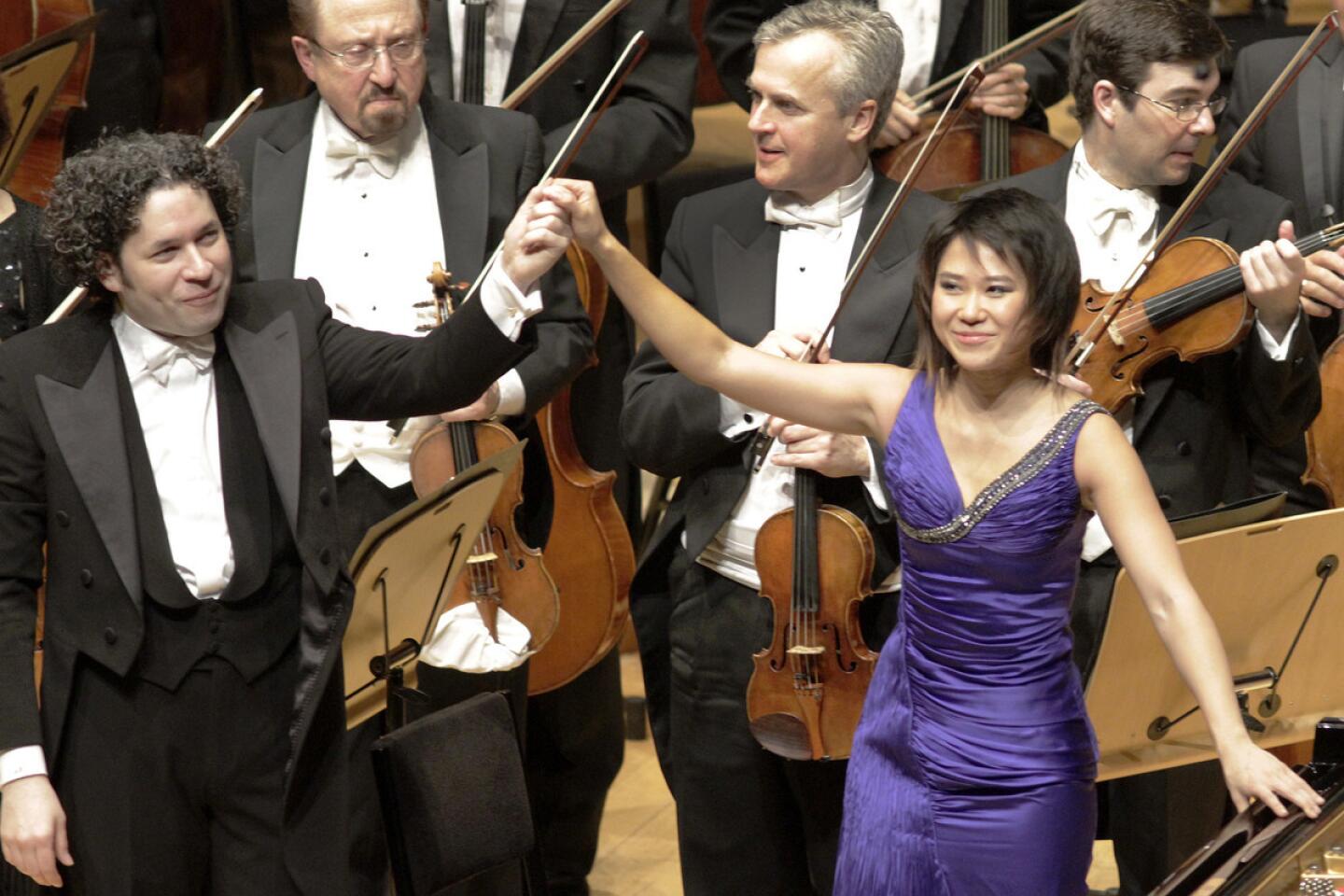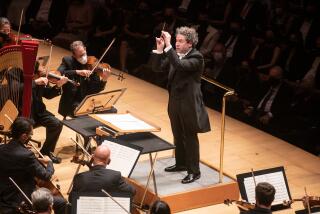Review: L.A. Phil’s ‘Bright’ and resounding closing at Disney Hall
Gustavo Dudamel is ending the Los Angeles Philharmonic’s year this weekend at Walt Disney Concert Hall with the world premiere of Daníel Bjarnason’s “Blow bright.” Which it did Thursday, if somewhat darkly bright, Bjarnason being, after all, an Icelandic composer.
He is a hot composer both for his alluring orchestral pieces and for his moody string arrangements for the Icelandic pop group Sigur Rós. He may have been one reason why a number of strikingly dressed young people were in the large audience. A certain young pianist with a fashion sense, Yuja Wang, on hand to play Rachmaninoff’s Third Piano Concerto, was another clear attraction.
Might there have also been, among the admirably mixed crowd, a Guinness World Records representative? I would think so. “Blow bright” is the seventh work commissioned and performed by the L.A. Phil this fall, the sixth given its world or U.S. premiere. It is also one of 10 works by living composers the orchestra has performed in the last 10 weeks. That’s got to be some kind of record for a modern major symphony orchestra.
FULL COVERAGE: Walt Disney Concert Hall at 10
And if we now must wait nearly a month for the next premiere — Veronika Krausas’ “Sillages,” written for four L.A. Phil basses — blame it on the holidays.
“Blow bright” takes its title from Philip Larkin’s poem, “Night-Music.” It takes its inspiration from the Pacific Ocean. An Icelander (born in Denmark) familiar with rough seas, Bjarnason has been entranced by an oceanic other on previous visits to Disney Hall for premieres of his works by the L.A. Phil New Music Group, Los Angeles Children’s Chorus and American Youth Symphony.
His 11-minute score uses a big orchestra and lots of glittering percussion. It may reveal the same sparkle that I encounter on walks along the Santa Monica beach on bright days, but his is nonetheless a frostier sea than the one I know, lighted by a glossier, more northern light.
It is a changeable sea, calm one minute but out of nowhere can come a sudden undertow that might dramatically sweep a body surfer under. A climax midway breaks off to the mysterious near nothingness of glassy string harmonics. A hint of a brass chorale brings the listener back to the surface with a smooth Sigur Rós-ian kind of close.
Wang had the ocean’s colors, too, wearing a dramatic purple gown a mermaid might admire. Her wardrobe matters only because when she played the Rach 3 at the Hollywood Bowl two summers ago, she used the occasion to suggest that a once demure pianist was, in her talked-about short skirt, demure no more. She’s since become a star, and audiences await a sensational entrance.
What is changing, though, is her playing. Her technique, always a selling point, makes speed seem effortless and phenomenal precision seem normal. A ferocious piano concerto under her fingers has no fury for a slight, unflappably secure superwoman.
PHOTOS: Arts and culture in pictures by The Times
Now, though, she makes more of everything. She can still toss off complex passage work like it’s nothing, which was Rachmaninoff’s own way of playing the work. But now she wants you to know what power might lie under specific notes. She stalls, she accents, she shapes phrases more willfully, and sometimes over-expression leads to less expression, especially when slow passages verge on melodrama.
But when she revs up, you simply go along for the ride. Thrills are thrills, and the last movement is nothing but. Dudamel, who has just recorded the concerto with her and the Simón Bolívar Orchestra, is on her side, with the orchestra and pianist being like two race cars side by the side on the track at Le Mans.
Still, that performance almost paled next to Dudamel’s first time conducting Stravinsky’s “Petrushka.” Here Dudamel made every grotesque gesture stand out with the vastly exaggerated vividness of pop art. Horns didn’t just blast away, they went KA-POW! Even from far away you could see the woodwind players turning red-faced trying to, well, blow impossibly bright.
Stravinsky’s recording of this ballet with the L.A. Phil (under the guise of the Columbia Symphony) in Hollywood in 1960 has recently been remastered in high-def sound. Listening to it, I sense that there was probably something in every single bar of Dudamel’s performance to which the composer, who advocated interpretive understatement, might have, in theory, objected.
Yet could even Stravinsky have entirely resisted the tremendous sweep and immediacy that Dudamel and today’s L.A. Phil brought to the performance? Written in 1911, two years after Rachmaninoff’s romantic concerto, “Petrushka” opened a new world. Dudamel revealed “The Rite of Spring,” two years away, around the corner. He also revealed hints of Tchaikovsky in the rear-view mirror.
Dudamel took big, crazy chances. He tried things no one else would dare, and that he might not again dare. The orchestra was not allowed into its Stravinskian comfort zone. “Blow bright” worked. Wang knew exactly where she was going in Rachmaninoff and never faltered. “Petrushka,” on the other hand, sounded made up on the spot. I wish Stravinsky could have been there.
--------------------------
Los Angeles Philharmonic
Where: Walt Disney Concert Hall, downtown Los Angeles
When: 8 p.m. Saturday and 2 p.m. Sunday
Tickets: Sold out
Information: (323) 850-2000 or https://www.laphil.com
More to Read
The biggest entertainment stories
Get our big stories about Hollywood, film, television, music, arts, culture and more right in your inbox as soon as they publish.
You may occasionally receive promotional content from the Los Angeles Times.












